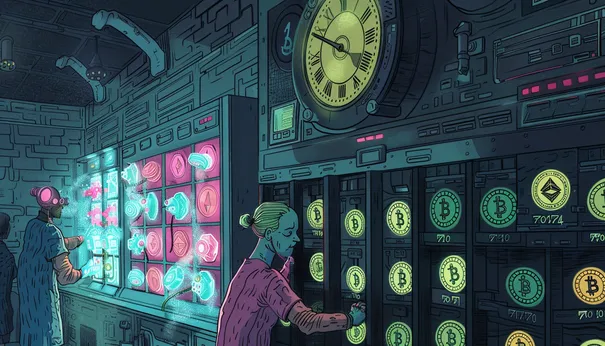What happens to Bitcoin after all 21 million are mined?

Scarcity is central to Bitcoin's value proposition. However, the path to reaching this cap and its implications for the network's security and economics are complex and worthy of deeper exploration.
The current state of Bitcoin mining and security
As of 2024, approximately 19.7 million bitcoins have been mined. New bitcoins are created through mining, where powerful computers validate transactions and add new blocks to the blockchain.
The crucial role of block rewards
Block rewards, which create new bitcoins, are essential for Bitcoin's security model:
- Economic incentives: Block rewards provide a strong economic incentive for miners to secure the network. This incentive is crucial because it aligns the miners' interests with the network's security.
- Inflationary mechanism: The creation of new bitcoins through block rewards is an inflationary mechanism that funds the network's security. This inflation is predictable and decreases over time.
- Distribution method: Block rewards serve as a fair distribution method for new bitcoins, encouraging a decentralized network of miners.
- Security budget: The value of newly minted bitcoins essentially acts as a "security budget" for the network. Miners invest in hardware and energy to compete for these rewards, and in doing so, they make it extremely costly to attack the network.
The halving process and its implications
Bitcoin's protocol includes a "halving" mechanism that reduces the block reward by 50% approximately every four years. This process is essential to Bitcoin's monetary policy and has significant implications:
Economic security and the need for price appreciation
With each halving, the number of new bitcoins entering circulation is cut in half. For the network's economic security to be maintained, one of two things needs to happen:
- Bitcoin's price must increase: If the price of Bitcoin doubles every four years, it would offset the reduction in the number of bitcoins awarded, maintaining the same level of economic security.
- Transaction fees must increase: If the price doesn't increase sufficiently, transaction fees would need to make up the difference to incentivize miners.
Let's break this down further:
- In 2020, the block reward halved from 12.5 to 6.25 bitcoins. In April 2024, the block reward halved from 6.25 to 3.125 BTC.
- For miners to receive the same economic value post-halving, Bitcoin's price needed to double.
- This pattern needs to continue with each halving for the security budget to remain constant in real terms.
The security budget challenge
The security budget (total value of block rewards) is critical because it determines how costly it is to attack the network. A higher security budget means:
- More miners are incentivized to participate
- More energy and computing power is dedicated to securing the network
- The cost of a potential 51% attack increases
If Bitcoin's price doesn't keep pace with the halvings, it could lead to:
- Reduced mining profitability
- Fewer miners securing the network
- Potentially increased vulnerability to attacks
What happens when all bitcoins are mined?
When the last bitcoin is mined around 2140, several crucial changes will occur:
1. Shift to a transaction fee-only model
With no more block rewards, miners will rely solely on transaction fees. This transition poses several challenges:
- Volatility in miner revenue: Transaction fees are more volatile than block rewards, potentially leading to unstable hash rates and security levels.
- Potential for security reduction: If transaction fees don't provide sufficient incentive, it could lead to a reduction in network security.
- Block space economics: The limited block space may become more valuable, potentially leading to higher fees but also pricing out smaller transactions.
2. Changes in Bitcoin's economic model
The end of new bitcoin issuance will mark a shift from a disinflationary to a non-inflationary or potentially deflationary model:
- Increased scarcity: With a truly fixed supply, each bitcoin could become more valuable if demand continues to grow.
- Potential for deflation: If bitcoins are lost over time and no new ones are created, the supply could slowly decrease, potentially leading to deflation.
3. Long-term sustainability challenges
The transition to a fee-only model raises questions about long-term sustainability:
- Security funding: Will transaction fees alone provide enough incentive to maintain a high level of network security?
- Miner consolidation: Lower rewards might lead to consolidation in the mining industry, potentially impacting decentralization.
- Evolving attack vectors: As the incentive structure changes, new types of attacks or vulnerabilities might emerge.
Potential solutions and adaptations
As we approach this milestone, the Bitcoin community may consider various solutions:
Protocol changes
Modifications to Bitcoin's protocol could be proposed to address these challenges, such as implementing a permanent but minimal inflation rate.
Layer-2 solutions
Continued development of Layer-2 solutions like the Lightning Network could help manage transaction volumes and fees.
New mining technologies
Advancements in mining technology could reduce costs and help maintain profitability even with lower rewards.
Evolving economic models
New economic models might emerge that balance security, user costs, and miner incentives in a post-block-reward era.
Conclusion
The gradual reduction of block rewards and the eventual end of bitcoin mining present significant challenges to Bitcoin's security model and economics. These challenges are not insurmountable, but they will require careful consideration and potentially innovative solutions from the Bitcoin community.
The need for Bitcoin's value to keep pace with halvings highlights the interconnectedness of its technology, economics, and security. As we move closer to the mining of the last bitcoin, these discussions will become increasingly important.
Understanding these dynamics is crucial for anyone looking to grasp Bitcoin's long-term potential and challenges. While the future remains uncertain, Bitcoin's ability to adapt to these changes will be a critical factor in its long-term success and relevance in the global financial landscape.